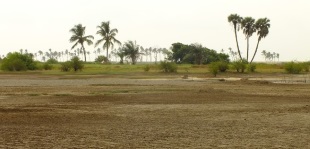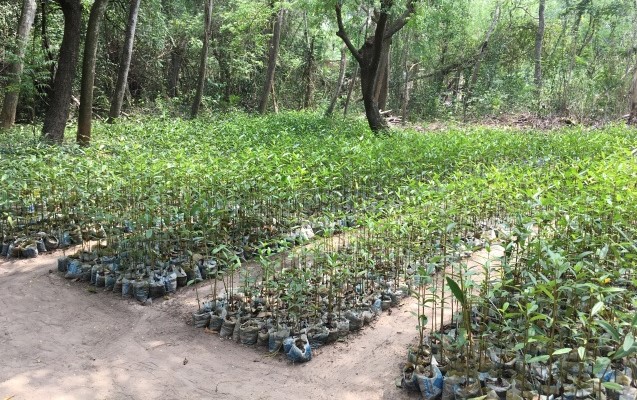Gods and mangroves in Ghana’s Songor Biosphere Reserve

The Mami Wata project team visits UNESCO Biosphere Reserve and shares its insights.
Dickson picked us up at 8 a.m. at our hotel in Ada, on the Volta estuary, in Ghana. It was 28 degrees Celsius and the humidity over 80 percent. The plan for the morning was to visit a few locations within the Songor Ramsar site and UNESCO Biosphere Reserve, one of the protected wetlands situated along the eastern portion of Ghana’s 550 kilometre sandy coast. Dickson Agyemang, the Biosphere Reserve Site Manager, served as our guide for the next four hours.
Our Mami Wata Project team was in Ada to meet with project partners and work on plans for this year. The IKI project helps develop marine management skills in West African countries of the Abidjan Convention (ABC).
The Songor lagoon was designated as a Ramsar conservation site in August 1992, meaning the wetland is considered to be of international importance under the Convention on Wetlands (known as the Ramsar Convention), an international environmental treaty established by the United Nations Educational, Scientific and Cultural Organization (UNESCO). The 51,000-hectare site was adopted as a Biosphere Reserve in June 2011 and consists of transition, buffer zone, and a core zone.
Biosphere Reserves are internationally recognised and set up to sustainably use and conserve the biological diversity of an area, as well as improve the relationship between people and their environment through community education and ecosystem restoration. Four species of globally threatened turtles – Green, Hawksbill, Leatherback and Olive Ridley – nest in the lagoon, and it is also home to two species of mangroves (Avicennia africana and Rhizophora racemosa), 57 kinds of migratory birds, manatees and other fauna and flora.

We all jumped in a minivan and drove 15 minutes to our first stop, the DansMa aquaculture construction site located in the buffer zone where a private company is planning to grow shrimp for export. The ponds were initially proposed to border a creek, but a buffer was created, consisting of a road, to keep the shrimp ponds away from the creek. The creek embankments were also raised, which is now impeding water to flood the area where the mangroves are growing.
The next stop was in an area at the boundary of the core zone, where the local communities process salt as some of the lagoon’s water evaporates during the dry season. Salt production is one of the main sources of revenue to meet the basic needs of the reserve’s residents.
Dickson then took us to a village where there has been a concerted effort to restore and plant mangroves through a collaboration between the community members and the Forestry Commission, which supplied the seedlings. The disappearance of mangroves has caused a decrease in rainfall, causing bush fires that prevent local people from replanting them over a larger area. Since the restoration and planting programme started, the rainfall is slowly returning to its previous levels. The reserve also faces challenges such as encroachment due to population growth, illegal hunting and unapproved resource extraction.
The restored mangroves provide a roosting and feeding place for migratory birds that attract tourists to the area. Residents also use some of the wood to build shelters. The hydrology of the Volta River estuary allows brackish water to flood some parts of the lagoon which provides a source of fish to the community. The mangrove restoration and alternative woodlot plantation is funded by the Global Environment Facility’s Small Grants Programme.

The penultimate stop of our journey took us to the southern part of the reserve which borders the Atlantic Ocean and provides long stretches of sandy beach suitable for turtle nesting. The commission regularly organises talks with local schools to educate them about the various turtle species, the protection and conservation efforts being made, and have them participate in the release of hatchlings to the sea. Of the seven local clans, only two consume turtle meat, while the others consider them gods.
The forestry commission has been fighting poaching and managed to reduce the number of poached turtles in 2018 with the goal of eliminating hunting in 2019. Turtles eggs are also threatened by dogs, crows and hawks. A refuge has been installed where the eggs are protected and monitored. Similar to other coastal zones around the world, erosion is a major challenge with the unstable beach losing sometimes two metres in a week. To fight erosion, local authorities have built barriers every 500 metres over a 22-kilometre stretch. The coastal environment provides employment in the hospitality industry, as well as boating and other recreational activities.

“This field visit was very informative in the broader context of Integrated Ocean Management,“ said Christian Neumann, Mami Wata Project Manager. “Some solutions implemented in the Songor Lagoon can be replicated in the Takoradi area in Ghana, as well as in Benin and Cote d’Ivoire, which are currently implementing two other Mami Wata pilot projects.”
The link has been copied to the clipboard
Contact
IKI Office
Zukunft – Umwelt – Gesellschaft (ZUG) gGmbH
Stresemannstraße 69-71
10963 Berlin






